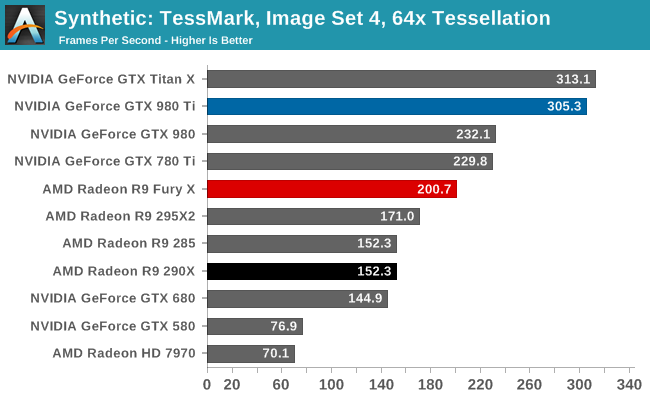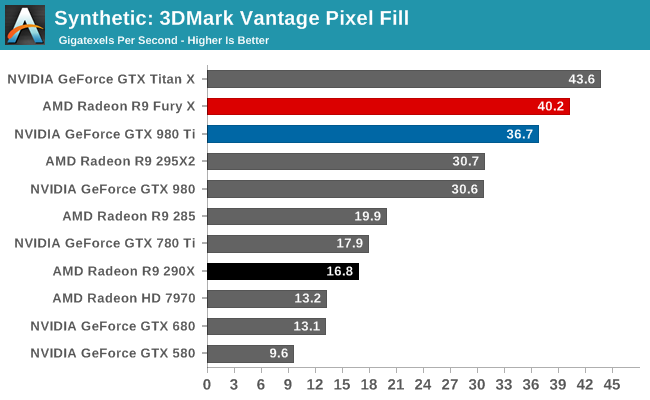The AMD Radeon R9 Fury X Review: Aiming For the Top
by Ryan Smith on July 2, 2015 11:15 AM ESTSynthetics
As always we’ll also take a quick look at synthetic performance. Since Fiji is based on the same GCN 1.2 architecture as Tonga (R9 285), we are not expecting too much new here.

First off we have tessellation performance. As we discussed in greater detail in our look at Fiji’s architecture, AMD has made some tessellation/geometry optimizations in GCN 1.2, and then went above and beyond that for Fiji. As a result tessellation performance on the R9 Fury X is even between than the R9 285 and the R9 290X, improving by about 33% in the case of TessMark. This is the best performing AMD product to date, besting even the R9 295X2. However AMD still won’t quite catch up to NVIDIA for the time being.

As for texture fillrates, the performance here is outstanding, though not unexpected. R9 Fury X has 256 texture units, the most of any single GPU card, and this increased texture fillrate is exactly in line with the theoretical predictions based on the increased number of texture units.

Finally, the 3DMark Vantage pixel fillrate test is not surprising, but it is none the less a solid and important outcome for AMD. Thanks to their delta frame buffer compression technology, they see the same kind of massive pixel fillrate improvements here as we saw on the R9 285 last year, and NVIDIA’s Maxwell 2 series. At this point R9 Fury X’s ROPs are pushing more than 40 billion pixels per second, a better than 2x improvement over the R9 290X despite the identical ROP count, and an important reminder of the potential impact of the combination of compression and HBM’s very high memory bandwidth. AMD’s ROPs are reaching efficiency levels simply not attainable before.










458 Comments
View All Comments
looncraz - Friday, July 3, 2015 - link
75MHz on a factory low-volting GPU is actually to be expected. If the voltage scaled automatically, like nVidia's, there is no telling where it would go. Hopefully someone cracks the voltage lock and gets to cranking of the hertz.chizow - Friday, July 3, 2015 - link
North of 400W is probably where we'll go, but I look forward to AMD exposing these voltage controls, it makes you wonder why they didn't release them from the outset given they made the claims the card was an "Overclocker's Dream" despite the fact it is anything but this.Refuge - Friday, July 3, 2015 - link
It isn't unlocked yet, so nobody has overclocked it yet.chizow - Monday, July 6, 2015 - link
But but...AMD claimed it was an Overclocker's Dream??? Just another good example of what AMD says and reality being incongruent.Thatguy97 - Thursday, July 2, 2015 - link
would you say amd is now the "geforce fx 5800"sabrewings - Thursday, July 2, 2015 - link
That wasn't so much due to ATI's excellence. It had a lot to do with NVIDIA dropping the ball horribly, off a cliff, into a black hole.They learned their lessons and turned it around. I don't think either company "lost" necessarily, but I will say NVIDIA won. They do more with less. More performance with less power, less transistors, less SPs, and less bandwidth. Both cards perform admirably, but we all know the Fury X would've been more expensive had the 980 Ti not launched where it did. So, to perform arguably on par, AMD is living with smaller margins on probably smaller volume while Nvidia has plenty of volume with the 980 Ti and their base cost is less as they're essentially using Titan X throw away chips.
looncraz - Thursday, July 2, 2015 - link
They still had to pay for those "Titan X throw away chips" and they cost more per chip to produce than AMD's Fiji GPU. Also, nVidia apparently had to not cut down the GPU as much as they were planning as a response to AMD's suspected performance. Consumers win, of course, but it isn't like nVidia did something magical, they simply bit the bullet and undercut their own offerings by barely cutting down the Titan X to make the 980Ti.That said, it is very telling that the AMD GCN architecture is less balanced in relation to modern games than the nVidia architecture, however the GCN architecture has far more features that are going unused. That is one long-standing habit ATi and, now, AMD engineers have had: plan for the future in their current chips. It's actually a bad habit as it uses silicon and transistors just sitting around sucking up power and wasting space for, usually, years before the features finally become useful... and then, by that time, the performance level delivered by those dormant bits is intentionally outdone by the competition to make AMD look inferior.
AMD had tessellation years before nVidia, but it went unused until DX11, by which time nVidia knew AMD's capabilities and intentionally designed a way to stay ahead in tessellation. AMD's own technology being used against it only because it released it so early. HBM, I fear, will be another example of this. AMD helped to develop HBM and interposer technologies and used them first, but I bet nVidia will benefit most from them.
AMD's only possible upcoming saving grace could be that they might be on Samsung's 14nm LPP FinFet tech at GloFo and nVidia will be on TSMC's 16nm FinFet tech. If AMD plays it right they can keep this advantage for a couple generations and maximize the benefits that could bring.
vladx - Thursday, July 2, 2015 - link
Afaik, even though TSMC's GinFet will be 16nm it's a superior process overall to GloFo's 14nm FF so I dount AMD will gain any advantage.testbug00 - Sunday, July 5, 2015 - link
TSMC's FinFET 16nm process might be better than GloFo's own canceled 14XM or whatever they called it.Better than Samsung's 14nm? Dubious. Very unlikely.
chizow - Sunday, July 5, 2015 - link
Why is it dubious? What's the biggest chip Samsung has fabbed? If they start producing chips bigger than the 100mm^2 chips for Apple, then we can talk but as much flak as TSMC gets flak over delays/problems, they still produce what are arguably the world's most advanced seminconductors, right there next to Intel's biggest chips in size and complexity.